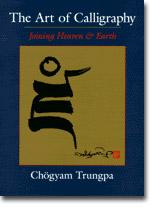"The Art of Calligraphy"

Author : Chögyam Trungpa
During the twenty-year period of his remarkable proclamation of Buddhist and Shambhala teachings in the West, calligraphy was a primary means of expression for Chogyam Trungpa. This book showcases fifty-eight of his brushworks--poems, seed syllables, and phrases as well as abstract images. Facing them are short, pertinent quotations from his prose and poetry. An essay entitled "Heaven, Earth, and Man," based on one of Trungpa's "dharma art" workshops, is also included. Here he emphasizes what he called "art in everyday life": the cool, peaceful expression of unconditional beauty that offers us the possibility of being able to relax enough to perceive the phenomenal world and our own senses properly. He goes on to show how the dynamic of heaven, earth, and man (the ancient Oriental hierarchy of the cosmos) is basic to any artistic endeavor--painting, building a city, or designing an airplane--as well as to perceiving the art that surrounds us. He also introduces the idea that "the discipline of art-making" can be used to organize and create a decent society.
During the twenty-year period of his remarkable proclamation of Buddhist and Shambhala teachings in the West, calligraphy was a primary means of expression for Chogyam Trungpa. This book showcases fifty-eight of his brushworks--poems, seed syllables, and phrases as well as abstract images. Facing them are short, pertinent quotations from his prose and poetry. An essay entitled "Heaven, Earth, and Man," based on one of Trungpa's "dharma art" workshops, is also included. Here he emphasizes what he called "art in everyday life": the cool, peaceful expression of unconditional beauty that offers us the possibility of being able to relax enough to perceive the phenomenal world and our own senses properly. He goes on to show how the dynamic of heaven, earth, and man (the ancient Oriental hierarchy of the cosmos) is basic to any artistic endeavor--painting, building a city, or designing an airplane--as well as to perceiving the art that surrounds us. He also introduces the idea that "the discipline of art-making" can be used to organize and create a decent society.
